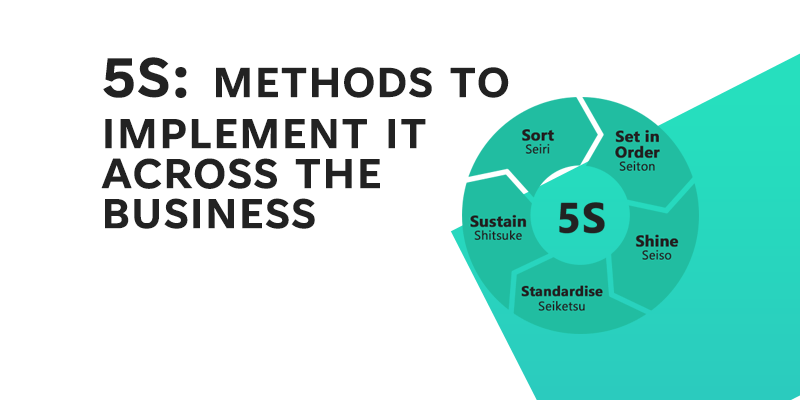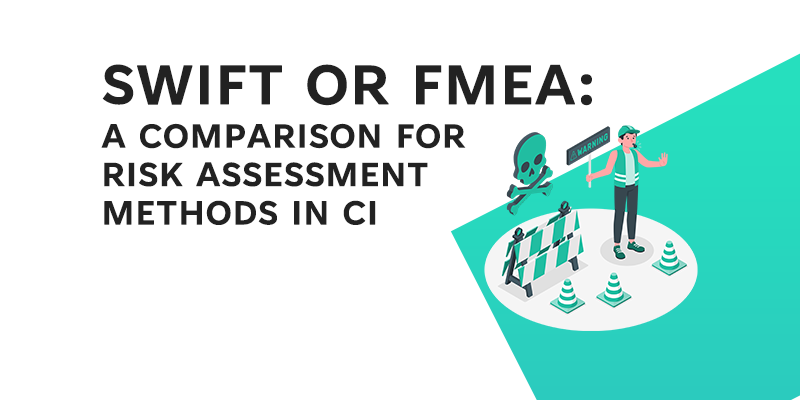Companies are constantly looking for ways to improve their processes and increase efficiency in today’s highly competitive business environment. Implementing 5S in the workplace, especially in sectors like factories and industries, has emerged as a sought-after solution. The 5S methodology is a crucial aspect of lean management, and the 5 steps of lean implementation are paramount for any organization striving for excellence. 5S is not just a procedure; it’s a systematic approach that focuses on maintaining a clean and well-organized work environment. Whether it’s 5S implementation in an office or a large-scale 5S implementation in a factory, the objective remains the same: to improve safety, quality, and productivity. This method not only provides tools for effective 5S implementation, but also insights into how to apply 5S procedures in various settings.
Table of Contents
What is 5S and why do Organizations need it
Before we delve into the intricacies of implementing 5S in the workplace or even in specific sectors like factories, it’s vital to understand 5S at its core. So, what is 5S and why do organizations need it?
5S is a Japanese workplace organization methodology that is now widely used across industries. It’s especially gaining traction with its implementation in factories and various industries. The 5 steps of lean implementation are embodied in the 5S system. They include: Sort, Set in Order, Shine, Standardize, and Sustain.
For those keen on diving deeper into the nuances of 5S, I recommend this guide on: 5S.
Organizations need 5S for a myriad of reasons, as it offers numerous advantages:
- Improved efficiency: By eliminating waste and minimizing errors, 5S forms the foundation of a 5S program implementation that bolsters efficiency. The result is shorter turnaround times, reduced lead times, and enhanced productivity.
- Increased safety: One of the core tenets of 5S implementation in industry is safety. 5S helps pinpoint and eradicate potential safety hazards, leading to fewer accidents and a boost in employee morale. This also means a decline in costs related to workplace mishaps.
- Enhanced quality: The implementation of 5S practices in companies has a significant impact on quality. Standardized processes birthed by 5S result in fewer defects, elevating customer satisfaction and profitability.
- Cost savings: Through tools 5S implementation offers, waste gets identified and eliminated. This translates to savings from excess inventory, redundant equipment, and lost time.
In essence, the 5S principles and implementation provide a robust methodology that aids organizations in honing efficiency, augmenting safety, refining quality, and trimming costs. By embracing and applying 5S procedures, organizations can foster a pristine and systematic workspace, paving the way for continuous improvement and reaping enduring benefits.
Where to Start with 5S
Step one: Identify where the biggest 5S Problem is
Imagine stepping into the role of a new Lean Manager or Continuous Improvement Manager. You’ve been tasked with implementing 5S in the workplace and across the entire business fabric, from the office to the factory floor. The pressing question is: Where do you begin?
The preliminary step involves scoping out the entire site. Utilize tools like Visio, Excel, or PowerPoint to map out the area. This visualization aids in pinpointing sectors that crave 5S implementation the most, whether it’s in an office setting or a more expansive 5S implementation in a factory. Post mapping, conduct a comprehensive 5S program implementation audit for each business segment. This is your chance to gauge the existing 5S implementation in industry segments and understand the present state of workplace organization.

It’s vital to ensure that each designated area remains concise, resembling a single machine zone, a room, or a distinct factory section with clear boundaries. Such granularity ensures a focused approach, permitting each segment to gain the right attention and resources for 5S principles and implementation.
During your audit, consistency remains key. Deploy a uniform 5S criterion to assess each zone, ensuring the audit’s impartiality and precision. A feasible method involves adopting a scoring mechanism grounded on the 5 steps of lean implementation: Sort, Set in Order, Shine, Standardize, and Sustain. This scoring offers insights into the strengths and shortcomings of each zone, a vital step before and after 5S implementation.
Upon audit completion, prioritize areas using the Pareto principle as your compass, recognizing that typically, 80% of the effects emanate from 20% of the causes. By channeling efforts towards the areas needing utmost attention, you fast-track the benefits of 5S implementation, reaping the rewards early in the process.
Step two: Identify the Operators of the 5S area
This step is crucial in ensuring the success of the 5S implementation process.
The operators identified from the worst 5S area are often the ones who are most affected by poor workplace organization, inefficient processes, and safety hazards. By supporting these operators, they become the champions of the 5S initiative and can help to drive the change across the site.
There are several reasons why identifying operators from the worst 5S area is important. Firstly, these operators are likely to have the most to gain from the 5S initiative. They may be experiencing frustration due to a lack of organization and efficiency, and may be more willing to support the initiative. By involving them in the process, they become invested in the success of the initiative and can provide valuable input and feedback.
Secondly, by identifying and supporting operators from the worst 5S area, you can demonstrate the benefits of the 5S initiative to other employees. When other employees see the improvements made by the champions, they are more likely to support the initiative and become involved in the process. This helps to create a culture of continuous improvement and engagement across the site.
Thirdly, by supporting the operators from the worst 5S area, you can help to address safety hazards and reduce the risk of accidents in the workplace. Poor workplace organization can lead to tripping hazards, falls, and other accidents that can cause injury or damage to equipment. By implementing 5S, you can identify and eliminate these hazards, making the workplace safer for all employees.
Step three: Understand and Train the Operators
This step is pivotal in ensuring the success of the 5S implementation process.
Operators pinpointed from the areas with the direst 5S challenges are frequently the ones most impacted by deficient workplace organization, sluggish processes, and safety threats. By backing these operators, they metamorphose into the champions of the 5S program implementation, steering transformative changes across the site.
Several reasons underscore the significance of identifying operators from these challenging 5S zones:
- Investment and Engagement: Primarily, these operators likely stand to benefit immensely from implementing 5S in the workplace. They might be grappling with the frustrations birthed by disorganization and inefficiency. Given this, they may be more receptive to the 5S initiative and, when included, become staunch stakeholders in its success. Their hands-on experiences can offer insightful input and feedback, enhancing the implementation of 5S practices in the company.
- Modeling Change: Secondly, by identifying and endorsing operators from the least organized 5S areas, you showcase the tangible perks of the 5S principles and implementation to the broader employee base. Witnessing the palpable enhancements driven by these 5S champions can galvanize other team members. This fosters a culture imbued with continuous refinement and deep-rooted engagement across the site.
- Safety and Protection: On the third front, supporting operators from these challenging 5S realms directly combats safety risks, slashing the probability of workplace mishaps. Before and after 5S implementation, it’s evident how a disheveled workplace can spawn hazards like trips or equipment mishaps. Through the meticulous apply 5S procedures, these hazards get identified and eradicated, crafting a sanctuary for all team members.
Step four: Implement 5S
Implementing 5S is the actualization phase, where all prior steps culminate into tangible action. Here’s a breakdown of how to go about this crucial step:
- Sort (Seiri): Begin by decluttering the workspace. Remove items that aren’t required for daily operations. This might involve disposing of obsolete equipment, recycling unused materials, or reallocating items to more appropriate locations. This step ensures that only necessary items remain in the workspace.
- Set in Order (Seiton): Organize the workspace. Designate specific locations for tools, materials, and equipment. Label everything clearly. The objective is to ensure that everything has its place, and everyone knows its place. This not only speeds up work processes but also reduces the time spent searching for tools or equipment.
- Shine (Seiso): Regularly clean and maintain the workspace. This isn’t just about aesthetics; it’s about functionality and safety. Cleaning often reveals potential issues before they become bigger problems, like a machine leak indicating a need for maintenance.
- Standardize (Seiketsu): Develop consistent practices and procedures. Ensure that everyone knows their responsibilities regarding the first three steps of 5S. Create visual aids, checklists, or even daily routines to make sure that everyone can follow the 5S procedures consistently.
- Sustain (Shitsuke): Ensure that 5S practices are maintained over the long term. Regular audits, continuous training, and management support are essential to make sure the organization doesn’t fall back into old habits. Celebrate successes and continuously look for ways to improve. Make 5S a part of the company culture.
Challenges in 5S Implementation:
No change process is without its challenges, and 5S is no exception. Here are some potential obstacles you might face:
- Resistance to Change: Employees might resist changing their habits, especially if they’ve been doing things a certain way for a long time. To counteract this, foster a culture of continuous improvement and ensure that everyone understands the benefits of 5S.
- Lack of Consistency: Without regular audits and reinforcement, it’s easy for areas to slip back into disorganization. To prevent this, schedule regular 5S reviews and make them a standard part of the business process.
- Lack of Management Support: For 5S to be effective, it needs to be supported at all levels, especially by management. Ensure that management understands the benefits of 5S and is committed to its implementation.
Conclusion:
Implementing 5S in the workplace is more than just a fleeting initiative; it’s an enduring journey towards continual enhancement. By initiating this journey in the most troublesome zones, and more specifically in spaces like factories where 5S implementation in a factory is paramount, involving the operators active in these regions becomes essential. Through their involvement and the steadfast application of the 5S principles and implementation, businesses can sculpt an optimized, safe, and top-notch workspace. Whether you’re focusing on the general 5S program implementation or more specific applications like 5S implementation in an office, the essence remains consistent.
The 5S methodology offers a plethora of advantages. The dividends of augmented efficiency, bolstered safety, refined quality, and tangible cost savings reverberate beyond balance sheets. They infuse a renewed sense of purpose in employees, elevating their morale. Additionally, they amplify customer satisfaction, underscoring the comprehensive impact of a robust 5S guidebook step by step implementation in any business setting.
References
- Sorooshian, S., Salimi, M., Bavani, S. and Aminattaheri, H., 2012. Case report: Experience of 5S implementation. Journal of Applied Sciences Research, 8(7), pp.3855-3859.
- Randhawa, J.S. and Ahuja, I.S., 2017. 5S implementation methodologies: literature review and directions. International Journal of Productivity and Quality Management, 20(1), pp.48-74.








